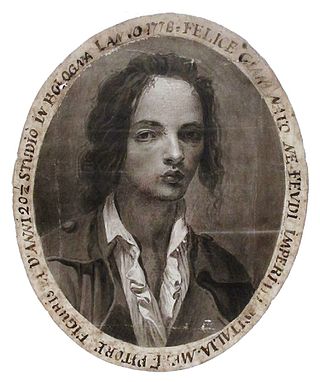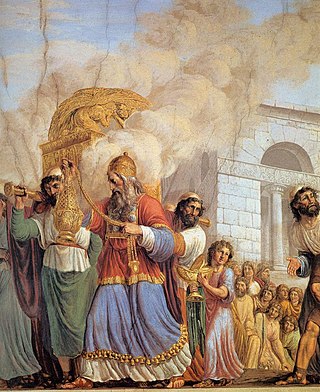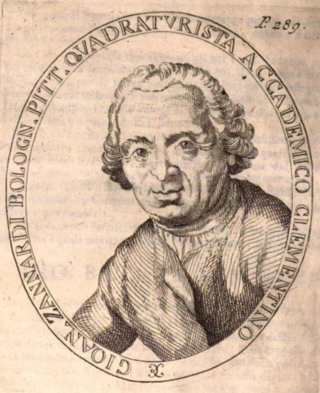Related Research Articles

The Galli–Bibiena family, or Galli da Bibiena, was a family of Italian artists of the 17th and 18th centuries, including:

Felice Giani was an Italian painter of the Neoclassic style. His grand manner subjects often included Greco-Roman allusions or themes.

Angelo Michele Colonna was an Italian painter of the Baroque period, active in Bologna, northern and central Italy and Spain. He is sometimes referred to as Michelangelo Colonna.
Giacomo Alboresi (1632–1677) was an Italian painter of the Baroque period.

Tommaso Aldrovandini was an Italian painter of the Baroque period. He mainly painted perspective views and architectural subjects (quadratura), in which the figures were painted by Marcantonio Franceschini and Carlo Cignani. He decorated churches, palaces, and theaters in Forlì, Verona, Venice, Parma, Turin, Ferrara, and Genoa, and especially in his native Bologna. Among his pupils was Giovanni Benedetto Paolazzi.

Pietro Fancelli was an Italian painter and set-designer.

San Procolo is an early Gothic-style, Roman Catholic church and former monastery-hospital located on Via Massimo D'Azeglio #52 in central Bologna, region of Emilia Romagna, Italy.
Nicola Bertucci was an Italian painter of the late-Baroque or Rococo style, mainly painting figures in landscapes. He is also called l'Anconitano or Nicolo Bertuzzi.
Gerolamo Mengozzi Colonna was an Italian painter, mostly of frescoed quadratura.

Luigi Ademollo was an Italian painter.

Giovanni Zanardi was an Italian painter of quadratura during the late Baroque period.
Filippo Maccari was an Italian painter and scenic designer, mainly painting quadratura.
Petronio Fancelli (1734–1800) was an Italian painter, active mostly as an ornamental quadratura painter in Bologna.
Gaetano Ghidetti was an Italian scenic designer, quadratura painter, and architect.

Stefano Orlandi was an Italian painter, active mainly in Bologna in the architectural perspective painting. He is known for painting fanciful architectural canvases, known as Capricci.

Gaetano Lodi was an Italian painter.
Luca Antonio Bistega or Luca Bestega was an Italian painter of quadratura, active mainly in Bologna, Italy.
Giovanni Battista Alberoni was an Italian painter, scenic designer, and engraver of the late-Baroque period, active in Bologna and Turin, mainly in quadratura painting. He died on New Years Eve 1784 at the age of 81.

Alessandro Baratta was an Italian painter and engraver.
Michele Mastellari was an Italian painter of quadratura, active during the mid-19th century in Bologna.
References
- ↑ Bryan mistakenly calls him Gaetaso, others may misspell his surname Alemanni
- ↑ Entry in Dizionario Biografico degli Italiani - Volume 2 (1960) by Rezio Buscaroli.
- ↑ Guida del forestiere per la città di Bologna e suoi sobborghi, by Girolamo Bianconi; Annesio Nobili, Bologna, 1820, page 451.